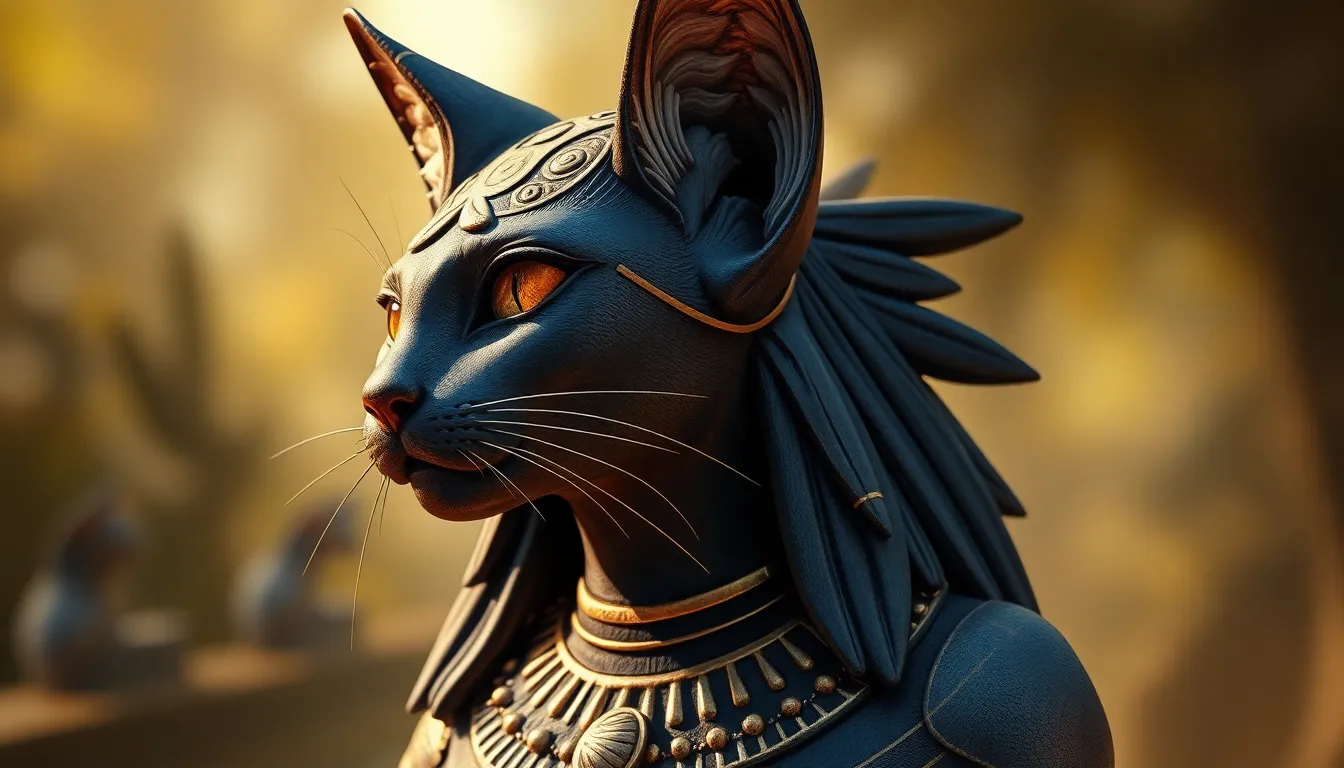Bastet: The Feline Goddess of Home and Fertility
I. Introduction
Bastet, the beloved feline goddess of ancient Egyptian mythology, holds a significant place in the pantheon of deities revered by the ancient Egyptians. Known for her nurturing qualities and fierce protective nature, Bastet embodies the duality of motherhood and ferocity. She is celebrated as the goddess of home, fertility, and domesticity, while also being associated with warfare and protection. This article explores the rich history, symbolism, and enduring legacy of Bastet in ancient Egyptian culture.
II. Historical Background
The origins of Bastet can be traced back to the early dynastic periods of ancient Egypt, where she was initially worshipped as a lioness goddess. Her fierce representation symbolized strength and protection, particularly in the context of warfare and safeguarding the pharaoh. Over time, her image evolved into that of a domestic cat, reflecting the shift in societal values towards home and family.
The transition from lioness to cat illustrates the changing nature of her worship. By the New Kingdom, Bastet was predominantly depicted as a woman with the head of a domestic cat, symbolizing affection and nurturing. This transformation marked her acceptance as a protector of the home and family, solidifying her role as a goddess of domesticity and fertility.
III. Symbolism and Attributes
Bastet is associated with several key symbols that reflect her diverse attributes:
- Cats: As her most recognized symbol, cats were revered as sacred animals, embodying grace, protection, and independence.
- Music: Bastet is often depicted with musical instruments, especially the sistrum, highlighting her association with joy and celebration.
- Joy and Dance: She represents happiness and festivity, often celebrated in songs and dances during her festivals.
Additionally, her attributes encompass home, fertility, and protection. As a goddess of fertility, she was called upon by women seeking to conceive and ensure the health of their children. Moreover, her protective nature made her a guardian against evil spirits, fostering a safe and nurturing environment for families.
IV. Bastet in Ancient Egyptian Society
Bastet played a vital role in the daily lives of ancient Egyptians. Her presence was felt in households, where statues and amulets bearing her likeness were commonplace. Families often kept cats as pets, which were believed to bring blessings and protection. The reverence for cats in ancient Egypt is well-documented, highlighting their association with Bastet.
Worship practices included offerings of food and flowers to her shrines, with many households maintaining small altars dedicated to the goddess. Festivals in honor of Bastet drew large crowds, celebrating her nurturing and protective attributes with music, dance, and feasting.
V. Festivals and Celebrations
One of the most significant festivals dedicated to Bastet was the Feast of Bubastis, held annually in her honor in the city of Bubastis (modern-day Tell Basta). This festival attracted thousands of participants who celebrated with music, dance, and communal gatherings.
During the festival, rituals included:
- Processions to the temple of Bastet, where offerings were made.
- Rituals involving the sistrum to invoke her blessings.
- Public feasting and merriment, showcasing the joy associated with the goddess.
The Feast of Bubastis was not only a religious event but also a time for socializing and reinforcing community bonds among the ancient Egyptians.
VI. Artistic Representations
Bastet has been depicted in various artistic forms throughout ancient Egyptian history. Her representations range from intricate carvings and paintings in tombs to statues and amulets. Common motifs include her with a lioness or domestic cat head, often adorned with jewelry and holding symbols of fertility and protection.
Across different dynasties, the portrayal of Bastet evolved:
- Early Dynastic Period: Depicted primarily as a lioness, emphasizing her fierce protective nature.
- Middle Kingdom: Shift towards a more domestic cat appearance, symbolizing nurturing and fertility.
- New Kingdom: Commonly represented as a woman with a cat’s head, often engaged in joyful activities.
These artistic variations reflect the changing perceptions of her role in society, from a fierce warrior goddess to a beloved protector of households.
VII. Modern Interpretations and Influence
In contemporary culture, Bastet continues to inspire interest in feline symbolism and spirituality. Many modern spiritual practices draw upon her attributes, celebrating the connection between cats and the divine feminine. Bastet’s image has found its way into popular culture, from literature to art, symbolizing independence and domestic tranquility.
The resurgence of interest in cats in modern society often invokes the spirit of Bastet, celebrating their roles as companions and protectors within the home. Many people see their pet cats as embodiments of the goddess, reflecting her grace, playfulness, and nurturing spirit.
VIII. Conclusion
Bastet remains an enduring symbol of home and fertility, transcending the boundaries of time and culture. Her dual nature as both a nurturing mother and a fierce protector resonates with many, reflecting the complexities of femininity. The legacy of Bastet is not only preserved in ancient texts and artifacts but also lives on in modern interpretations and the cherished presence of cats in our homes. As a goddess who embodies joy, protection, and the spirit of motherhood, Bastet continues to inspire and nurture the hearts of many, bridging the ancient past with contemporary life.




